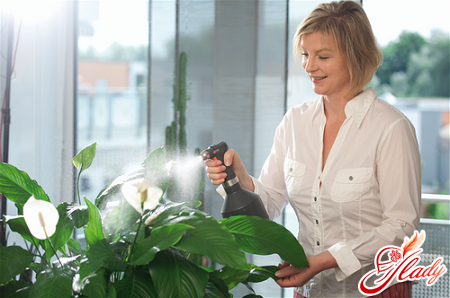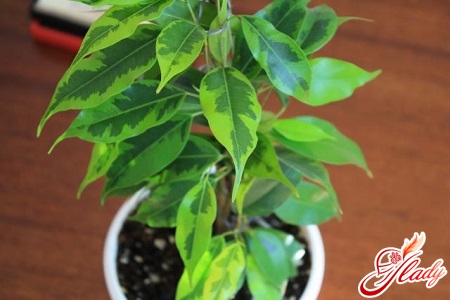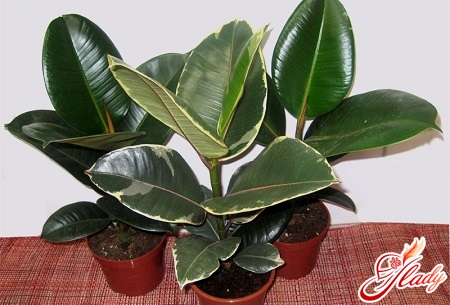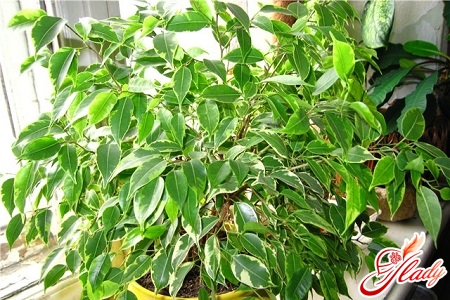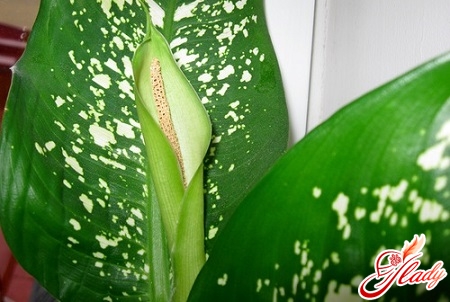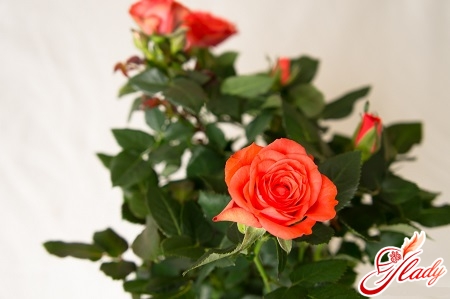 Home roses - small copies of your gardenlarge relatives - have long won great popularity. Their tender little buds can decorate even the most modest interior, bringing joy to the owners of the house. How to properly care for a rose, this whimsical beauty, at home? What you need to do to ensure that it is as long as possible to please you and feel good? Their secrets are shared with readers by specialists - check your care of the flower with their advice. At home, you can grow only dwarf varieties of roses, as the bushes of garden roses have too long roots - they simply do not have enough space in the pot. Caring for a rose involves a number of conditions. Plants should be placed in a sunny, bright, well-ventilated place. In the summer it is better to keep it on the balcony, and in winter - away from central heating batteries, preferably at a temperature of 10-12 °. To water a house rose it is necessary regularly, but it is moderate. Water should not stagnate. In winter, the watering of roses should be reduced, and in summer, fertilizer should be applied twice a month. Wilted flowers on it should be removed immediately. Growing roses in the room, always really want them to regularly form buds and blossom. And every housewife wants to know how to take care of home roses to achieve this. The main condition for this - they need to grow in a cool room. But for the formation of buds, they require a lot of light. To do this, keep indoor roses in well-lit places. Roses can be grown in warm rooms, but then you will have to change care: you will often need to spray them with water. And the water should be a couple of degrees above room temperature. If the rose is sprinkled with cold water, it can cause a disease with powdery mildew. It is not deadly for a plant, but it greatly damages its appearance, so it is best to choose the correct water temperature. In summer it is better to place flowers on the balcony. If possible, transplant them into the ground, and you can do it right in the pots. At this time, the development and growth of roses beneficially affects the care, which includes morning and evening spraying with water. It will help not only to wash off dust and refresh the plant, but also to prevent the appearance of pests. Do this only on sunny days, because in cloudy weather spraying stops the growth of plants. Indoor roses can be kept in the fresh air until frost, after which they are returned to the house and resume normal care. It is impossible in any case to allow a lump of earth, and with it roots, to dry up. To water a house rose it is necessary in the morning and in the evening, before full saturation of a ground. But only in no case in the sun. It is impossible to wet the earth with water. The water temperature should be within 20 ° C. In order for the shoots wood to mature better, by the end of the summer watering is gradually reduced. In order to stop the growth of pots with plants in late autumn, they are taken out of the ground. Late buds are pruned. The land for indoor roses growing in flowerpots should be nutritious. A good substrate is prepared from two parts of a mixture of sand and clay mixed with powdered bird droppings and two parts of greenhouse humus. The earth taken from the nettle is very good for a rose. This is simply explained - the nettle always grows on nutrient-rich soils.
Home roses - small copies of your gardenlarge relatives - have long won great popularity. Their tender little buds can decorate even the most modest interior, bringing joy to the owners of the house. How to properly care for a rose, this whimsical beauty, at home? What you need to do to ensure that it is as long as possible to please you and feel good? Their secrets are shared with readers by specialists - check your care of the flower with their advice. At home, you can grow only dwarf varieties of roses, as the bushes of garden roses have too long roots - they simply do not have enough space in the pot. Caring for a rose involves a number of conditions. Plants should be placed in a sunny, bright, well-ventilated place. In the summer it is better to keep it on the balcony, and in winter - away from central heating batteries, preferably at a temperature of 10-12 °. To water a house rose it is necessary regularly, but it is moderate. Water should not stagnate. In winter, the watering of roses should be reduced, and in summer, fertilizer should be applied twice a month. Wilted flowers on it should be removed immediately. Growing roses in the room, always really want them to regularly form buds and blossom. And every housewife wants to know how to take care of home roses to achieve this. The main condition for this - they need to grow in a cool room. But for the formation of buds, they require a lot of light. To do this, keep indoor roses in well-lit places. Roses can be grown in warm rooms, but then you will have to change care: you will often need to spray them with water. And the water should be a couple of degrees above room temperature. If the rose is sprinkled with cold water, it can cause a disease with powdery mildew. It is not deadly for a plant, but it greatly damages its appearance, so it is best to choose the correct water temperature. In summer it is better to place flowers on the balcony. If possible, transplant them into the ground, and you can do it right in the pots. At this time, the development and growth of roses beneficially affects the care, which includes morning and evening spraying with water. It will help not only to wash off dust and refresh the plant, but also to prevent the appearance of pests. Do this only on sunny days, because in cloudy weather spraying stops the growth of plants. Indoor roses can be kept in the fresh air until frost, after which they are returned to the house and resume normal care. It is impossible in any case to allow a lump of earth, and with it roots, to dry up. To water a house rose it is necessary in the morning and in the evening, before full saturation of a ground. But only in no case in the sun. It is impossible to wet the earth with water. The water temperature should be within 20 ° C. In order for the shoots wood to mature better, by the end of the summer watering is gradually reduced. In order to stop the growth of pots with plants in late autumn, they are taken out of the ground. Late buds are pruned. The land for indoor roses growing in flowerpots should be nutritious. A good substrate is prepared from two parts of a mixture of sand and clay mixed with powdered bird droppings and two parts of greenhouse humus. The earth taken from the nettle is very good for a rose. This is simply explained - the nettle always grows on nutrient-rich soils. 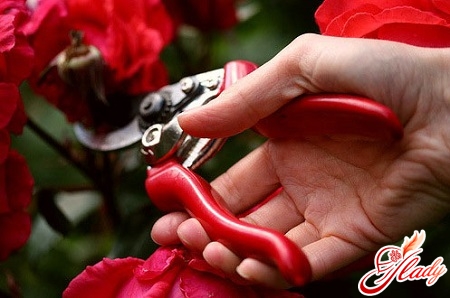
Pests and diseases of roses
Home flowers-queens, as well as their gardenrelatives, are not insured, unfortunately, from pests and diseases. They can be planted with aphids, spider mites and rosannys sawfly. To save the plant from aphids, it is washed with soapy water. Such care should be repeated every week and a half. Good results are also obtained by treating domestic roses with pyrethrum. For this, 200 g of powdered pyrethrum is insisted for twelve hours in ten liters of water. Then, in 10 liters of water, dissolve 50 ml of the solution and 50 g of soap. In the fight against spider mites, aphids and other pests, water extract of garlic is very effective. For this purpose, 50 g of crushed garlic is poured into a glass of cold water. After a quarter of an hour, the mass must be filtered and water added, so that the total volume is one liter. On a bucket of water take a half cup of this solution and in cloudy weather or in the evening they wash the plant. For prevention, it is advised to use granite dusts against spider mites and powdery mildews. It is mixed with the soil in spring, summer and autumn. For the same purpose, the soil and plant are dusted with ashes.
Transplanting roses
To receive a potted rose, planting it inPots from the soil must be produced in August. Then the transplanted roses till the winter manage to take root and by the spring of next year they will blossom. If the transplant is done in the spring, they will take root throughout the summer, and will blossom only next year. For the planting of house roses, small flowerpots are taken, because in large pots the soil dries much slower and can sour. From this, the roots can rot. In addition, in large pots, the home rose "fats": it gives few flowers and many leaves. Try to grow flowers in small pots, more often transplanting them into nutrient mixtures and feeding fertilizers. Transplanting a home rose in a period of growth, try not to break the earthen lumber, so as not to damage the root system. So roses can be transplanted all summer. In order for the plant to take root better, it is put on for five to seven days in the shade and moderately watered. 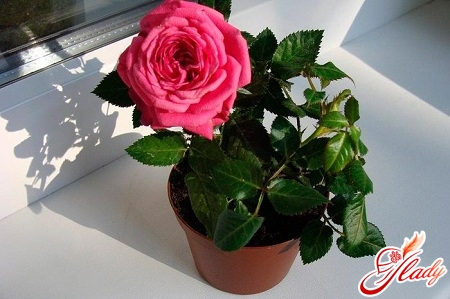
Pruning roses
Pruning of home roses is done to improve flowering and the formation of a bush. It should be done like this:
- First, cut out small, underdeveloped, weak, intertwined branches;
- Leave on the bush four or five of the strongestshoots that have medium height and normal development; if the wood on them is well ripened, they are cut off, while leaving on each shoot from three to six eyes;
- On sprouts of moderate strength, four or five eyes are left;
- On slabroslyh shoots leave two or three eyes.
Multi-colored dwarf flowers with large budsCrop better for three to five eyes in the spring. Small-colored dwarf roses give abundant flowering, if they are cut into two or three eyes. With small interruptions they bloom until the end of the vegetation. After trimming, the flowers are immediately introduced into a room with a temperature of 10-12 ° C. This is to ensure that the eye sights grow slowly. After the appearance of the first leaves, the plant must be transferred to a solar window. All new shoots need to be cut to the ground so that they do not take nutrients from the bush and do not suspend its development. In this case, powerful shoots and large buds develop. We told you how to take care of roses at home. If you follow these tips correctly, your favorite flowers will delight you for a long time with luxurious flowering. It only remains to add that if you were given a gift or you bought a potted rose in the store, do not rush to replace it. Let the plant for a couple of weeks get used to the new microclimate for it. We advise you to read:




